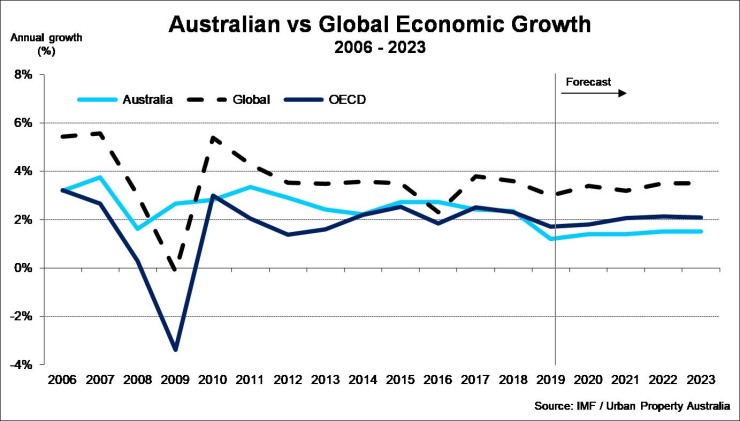Q3 2019 – Australian Economic Overview
October 22nd 2019 | , Urban Property Australia
The Australian economy continues to slow, expanding by just 0.5% in the June 2019 quarter. Over the year to June 2019, the Australian economy grew by 1.4%, the slowest growth rate since 2009. Nevertheless, there had been a pick-up in quarterly GDP growth over the first half of 2019 compared with the second half of 2018. The pick-up had been driven by stronger growth in exports, led by exports of resources and manufacturing goods which has been aided by the lower level of the Australian dollar.
In order to support the ailing Australian economy, the Reserve Bank of Australia cut official interest rates to 0.75%. The RBA has now cut the interest three times since June 2019 with most economists forecasting a further interest rate to be made in early 2020. However, the RBA has acknowledged the impact of any further cuts from current low levels will have a minimal effect on stimulating the economy and instead flagged that unconventional measures such as quantitative easing or negative interest rates may be required if the government doesn’t intervene.

However, the low level of interest rates, recent tax cuts, ongoing spending on infrastructure, signs of stabilisation in some established housing markets and a brighter outlook for the resources sector should all support growth in the short term.
While accommodative monetary policy and labour market conditions are expected to provide ongoing support, Australia’s economy is forecast to grow by 2.5% this year (down from 3.25% as previously projected), 2.75% over 2020 (down from 3% previously projected) and 3.0% in 2021.
Amid this slowdown in the domestic economy, the consumer confidence index has now fallen into pessimistic territory, and its lowest level since September 2017.
The main domestic uncertainty continues to be the outlook for consumption, with the sustained period of only modest increases in household disposable income continuing to weigh on consumer spending.
Consistent with the ongoing low growth in household disposable income, household consumption had increased by only 1.4% over the year to the end of June with retail sales still subdued in July and a decrease in car sales in August.
The residential construction sector has contracted further and this is expected to deteriorate further. The decline in dwelling investment in the June quarter was greater than had been expected. Higher-density approvals had declined in July, to be at their lowest level in seven years; detached approvals had also declined in July impacted by a softening of pre-sales for new developments.
Business investment had decreased a little in the June quarter, driven by a decline in non-residential construction outside the mining sector. Nevertheless, the outlook for non-mining business investment remained favourable, supported by investment in infrastructure. Mining investment had picked up largely as expected.
Employment has continued to grow strongly and labour force participation is at a record high. The unemployment rate has, however, remained steady at around 5.2% over recent months. Forward-looking indicators of labour demand indicate that employment growth is likely to slow from its recent fast rate. Wages growth remains subdued and there is little upward pressure at present, with increased labour demand being met by more supply.
With the exception of Northern Territory and Western Australia, all Australian states and territories recoded growth in state final demand over the year to June 2019 with only Tasmania expanding above its respective 10-year averages. Tasmania recorded the greatest growth, up 3.1% followed by ACT up 2.7% and Victoria (1.9%). NSW’s economy recorded growth of 1.3%, its lowest growth rate since 2013 impacted by slowing population growth and the peak of the infrastructure spending.
Copyright © 2019 by Urban Property Australia All rights reserved. No part of this publication may be reproduced in any form, by microfilm, xerography, electronically or otherwise, or incorporated into any information retrieval system, without the written permission of the copyright owner.



